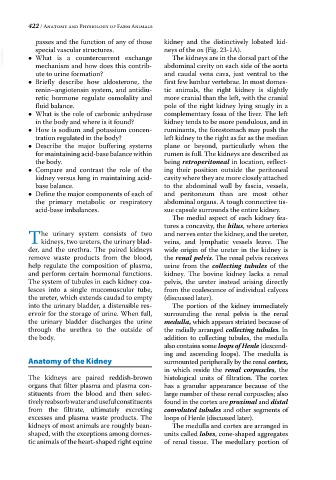Page 437 - Anatomy and Physiology of Farm Animals, 8th Edition
P. 437
422 / Anatomy and Physiology of Farm Animals
passes and the function of any of those kidney and the distinctively lobated kid-
special vascular structures.
neys of the ox (Fig. 23‐1A).
VetBooks.ir • What is a countercurrent exchange abdominal cavity on each side of the aorta
The kidneys are in the dorsal part of the
mechanism and how does this contrib-
ute to urine formation? and caudal vena cava, just ventral to the
• Briefly describe how aldosterone, the first few lumbar vertebrae. In most domes-
renin–angiotensin system, and antidiu- tic animals, the right kidney is slightly
retic hormone regulate osmolality and more cranial than the left, with the cranial
fluid balance. pole of the right kidney lying snugly in a
• What is the role of carbonic anhydrase complementary fossa of the liver. The left
in the body and where is it found? kidney tends to be more pendulous, and in
• How is sodium and potassium concen- ruminants, the forestomach may push the
tration regulated in the body? left kidney to the right as far as the median
• Describe the major buffering systems plane or beyond, particularly when the
for maintaining acid‐base balance within rumen is full. The kidneys are described as
the body. being retroperitoneal in location, reflect-
• Compare and contrast the role of the ing their position outside the peritoneal
kidney versus lung in maintaining acid‐ cavity where they are more closely attached
base balance. to the abdominal wall by fascia, vessels,
• Define the major components of each of and peritoneum than are most other
the primary metabolic or respiratory abdominal organs. A tough connective tis-
acid‐base imbalances. sue capsule surrounds the entire kidney.
The medial aspect of each kidney fea-
tures a concavity, the hilus, where arteries
he urinary system consists of two and nerves enter the kidney, and the ureter,
T kidneys, two ureters, the urinary blad- veins, and lymphatic vessels leave. The
der, and the urethra. The paired kidneys wide origin of the ureter in the kidney is
remove waste products from the blood, the renal pelvis. The renal pelvis receives
help regulate the composition of plasma, urine from the collecting tubules of the
and perform certain hormonal functions. kidney. The bovine kidney lacks a renal
The system of tubules in each kidney coa- pelvis, the ureter instead arising directly
lesces into a single mucomuscular tube, from the coalescence of individual calyces
the ureter, which extends caudad to empty (discussed later).
into the urinary bladder, a distensible res- The portion of the kidney immediately
ervoir for the storage of urine. When full, surrounding the renal pelvis is the renal
the urinary bladder discharges the urine medulla, which appears striated because of
through the urethra to the outside of the radially arranged collecting tubules. In
the body. addition to collecting tubules, the medulla
also contains some loops of Henle (descend-
ing and ascending loops). The medulla is
Anatomy of the Kidney surmounted peripherally by the renal cortex,
in which reside the renal corpuscles, the
The kidneys are paired reddish‐brown histological units of filtration. The cortex
organs that filter plasma and plasma con- has a granular appearance because of the
stituents from the blood and then selec- large number of these renal corpuscles; also
tively reabsorb water and useful constituents found in the cortex are proximal and distal
from the filtrate, ultimately excreting convoluted tubules and other segments of
excesses and plasma waste products. The loops of Henle (discussed later).
kidneys of most animals are roughly bean‐ The medulla and cortex are arranged in
shaped, with the exceptions among domes- units called lobes, cone‐shaped aggregates
tic animals of the heart‐shaped right equine of renal tissue. The medullary portion of

